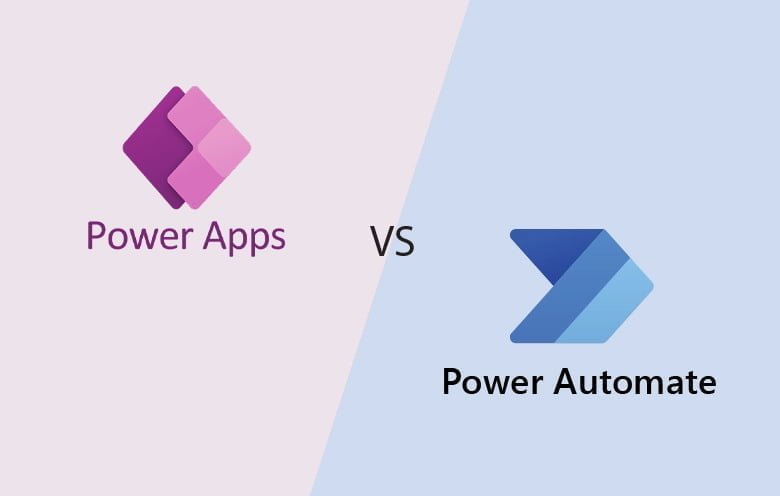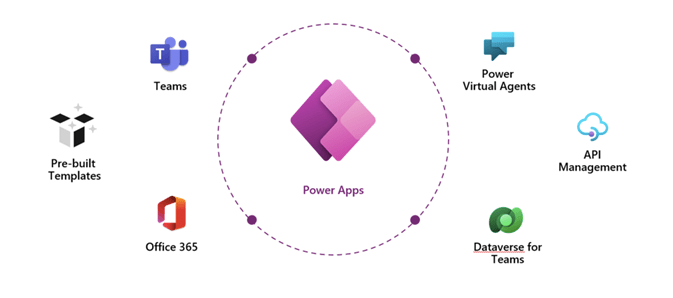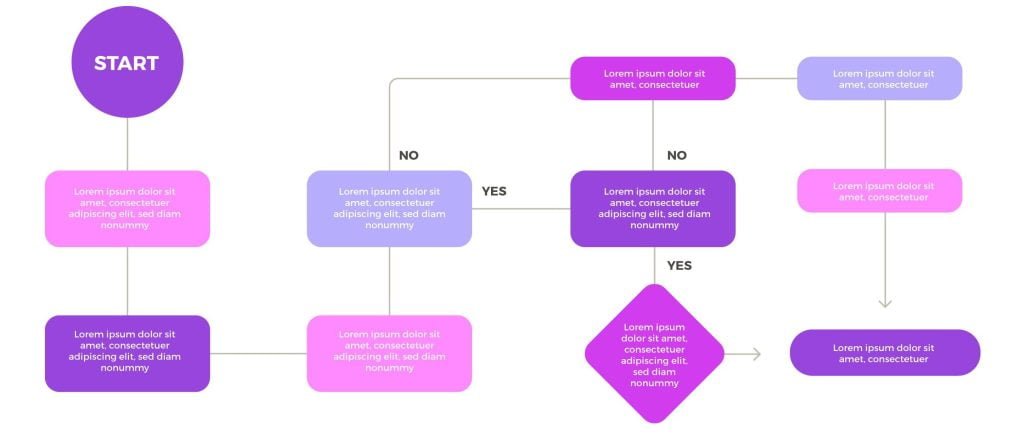Microsoft Power Apps and Power Automate are integral components of the Microsoft Power Platform, offering robust solutions for app development and workflow automation. In today’s fast-paced business environment, maintaining a competitive edge necessitates the optimization of workflows and the improvement of productivity. Microsoft provides two essential tools, Power Apps and Power Automate, designed to assist in accomplishing these objectives.
While both tools are interrelated and share a unified platform, they serve distinct purposes and are more effective for particular tasks. Utilizing Power Apps and Power Automate enables you to streamline and automate your business processes, tackling the contemporary challenges faced in the business landscape but what is the difference between Power Automate and Power Apps?

Credits: Softweb Solutions
Power Apps
Power Apps is a dynamic tool within the Microsoft ecosystem designed to empower organizations to construct custom business applications tailored to their unique operational needs. Here’s a deeper dive into its focus and capabilities:
Power Apps Focus: Custom Business Application Development
Power Apps is primarily aimed at enabling businesses to develop bespoke applications that cater to specific organizational requirements. This focus on customization is pivotal for companies looking to digitize and streamline their processes without the need for extensive software development resources.
Power Apps Capabilities:
i) User Interface Creation
One of the core functionalities of Power Apps is its ability to create intuitive and interactive user interfaces (UIs). This feature allows for the efficient collection, visualization, and interaction with data, making it simpler for end-users to navigate and perform tasks within the application. Whether it’s for inputting information, viewing reports, or managing operations, the UIs designed with Power Apps ensure a seamless user experience.
ii) Integration with Various Data Sources
Power Apps stands out for its versatility in integrating with a wide array of data sources, including SharePoint, Excel, Dynamics 365, and many others. This integration capability ensures that businesses can leverage their existing data infrastructure, facilitating the easy import and export of data between applications and systems. By connecting with these data sources, applications built with Power Apps can serve as central hubs for managing and manipulating organizational data, enhancing data coherence and accessibility across departments.

Credits: Softweb Solutions
iii) Low-Code/No-Code Development Environment
A significant advantage of Power Apps is its low-code/no-code development environment, which democratizes the application development process. This environment allows individuals with minimal coding expertise, often referred to as citizen developers, to construct powerful applications. The low code/no-code approach reduces the complexity and time required to build applications, enabling faster deployment and iteration. This is particularly beneficial for organizations looking to rapidly respond to changing business needs without the need for significant IT resources.
iv) Accessibility Across Devices
Applications developed with Power Apps are not confined to desktop environments; they can be accessed and used across web browsers and mobile devices. This cross-platform accessibility ensures that users can interact with applications anytime and anywhere, increasing productivity and operational flexibility. Whether in the office or on the go, employees have the tools they need at their fingertips, fostering a more connected and efficient workforce.
In summary, Power Apps provides a comprehensive suite of tools for businesses looking to innovate and optimize their operations. Through its focus on building custom business applications, combined with its capabilities in UI creation, data integration, low-code development, and cross-platform accessibility, Power Apps is an invaluable asset for organizations striving to stay ahead in today’s competitive business landscape.
Power Automate
Power Automate, a key component of Microsoft’s Power Platform, previously referred to as Microsoft Flow, is designed to revolutionize the way businesses approach task and workflow automation. By focusing on the automation of repetitive tasks and workflows, Power Automate enables organizations to enhance efficiency and reduce the time spent on manual processes. Let’s delve deeper into the capabilities and features that make Power Automate a pivotal tool for modern businesses.
Power Automate Focus: Streamlining Workflows and Repetitive Tasks
Power Automate’s primary aim is to simplify complex business processes and automate time-consuming, repetitive tasks. This focus is instrumental in freeing up valuable employee time, allowing staff to concentrate on more strategic, high-value activities. By automating routine tasks, businesses can not only increase productivity but also minimize the potential for human error, leading to more reliable and consistent outcomes.
Power Automate Capabilities:
i) Automated Workflow Creation with Drag-and-Drop Interface
One of the standout features of Power Automate is its user-friendly drag-and-drop interface, which simplifies the process of creating automated workflows. This intuitive design enables users, regardless of their technical expertise, to easily define and implement automation logic. Users can visually map out the steps of a workflow, making it easier to understand, design, and modify processes as business needs evolve.

Sample of Workflow Chart
ii) Integration with Diverse Services and Applications
Power Automate excels in its ability to connect with a wide array of services and applications, both within the Microsoft ecosystem and beyond. This extensive connectivity allows businesses to trigger actions automatically based on specific events across different platforms. For example, an automated workflow could be set up to receive notifications from a CRM system, process the
information, and then update a record in an ERP system, all without manual intervention. This seamless integration capability ensures that workflows can be as comprehensive and efficient as possible.
iii) Streamlining Manual Processes
By automating manual tasks, Power Automate streamlines business processes, making operations smoother and more efficient. From simple tasks like sending out automated email responses to more complex processes like data entry and validation, Power Automate can handle a wide range of activities. This capability not only saves time but also ensures that processes are carried out consistently, reducing the likelihood of errors and discrepancies.
iv) Desktop and Expanding Mobile Capabilities
While Power Automate is primarily desktop-based, offering robust automation solutions that integrate deeply with desktop applications and services, its mobile capabilities are rapidly expanding. This development is significant for businesses seeking to enable automation on-the-go, allowing users to manage workflows and receive notifications directly from their mobile devices. The expansion of mobile capabilities ensures that Power Automate remains a versatile and accessible tool for businesses, catering to the needs of a mobile and dynamic workforce.
In conclusion, Power Automate stands as a powerful ally for businesses aiming to automate repetitive tasks and streamline workflows. Through its easy-to-use interface, extensive integration options, ability to streamline manual processes, and expanding mobile capabilities, Power Automate not only boosts operational efficiency but also empowers businesses to focus on growth and innovation. By leveraging Power Automate, organizations can ensure that they remain agile and responsive in the fast-paced business environment of today.
This table outlines the principal difference between Power Apps and Power Automate:
| Feature | Power Apps | Power Automate |
|---|---|---|
| Purpose | Building custom business applications | Automating repetitive tasks and workflows |
| Output | User interfaces (UIs) | Automated workflows |
| Development Approach | Low-code development | Drag-and-drop interface |
| Data Sources | Integrates with various data sources | Connects to various services and applications |
| Accessibility | Web browsers and mobile devices | Primarily desktop-based (mobile capabilities expanding) |
Selecting the appropriate tool between Microsoft Power Apps and Power Automate hinges on the specific requirements and objectives of your project or organizational needs. Here’s an elaboration on how to make the right choice:

Opt for Power Apps when:
Developing Tailored Business Solutions: Power Apps is the go-to choice when the goal is to construct custom applications that cater to unique business demands. This platform enables the creation of tailored solutions that align perfectly with your organizational processes, enhancing overall efficiency and user experience.
Designing Interactive User Interfaces: If your project involves creating dynamic user interfaces that facilitate seamless data collection, visualization, and interaction, Power Apps offers the tools necessary to achieve this. Its capabilities allow for the development of intuitive UIs that can significantly improve the way users interact with your application, making data handling a more streamlined and user-friendly experience.
Integrating with Diverse Data Sources: Power Apps shines in scenarios where there is a need to connect with a variety of data sources such as SharePoint, Excel, Dynamics 365, and more. This integration capacity ensures that your custom applications can easily retrieve, display, and manipulate data from across your organization’s ecosystem, providing a cohesive and integrated solution.
Opt for Power Automate when:
Automating Repetitive Tasks and Workflows: When the objective is to eliminate the tedium of repetitive tasks and automate complex workflows, Power Automate stands out as the ideal solution. This tool is specifically designed to simplify your processes, allowing for the automation of tasks that would otherwise consume valuable time and resources.
Streamlining Processes: Power Automate is particularly useful when looking to enhance operational efficiency by reducing manual effort in business processes. By automating these tasks, you not only save time but also minimize the likelihood of human error, leading to more consistent and reliable outcomes.
Triggering Actions Across Services and Applications: If your project involves initiating actions based on specific events across different platforms, Power Automate provides the necessary connectivity. Its ability to link various services and applications enables you to set up triggers that automatically execute actions, ensuring that your workflows are both dynamic and responsive to real-time events.
In summary, the decision to use Power Apps or Power Automate should be guided by the nature of your project. Power Apps is best suited for projects that require custom application development with an emphasis on user interface and data integration. On the other hand, Power Automate is the preferred option for automating repetitive tasks, streamlining processes, and connecting different services and applications to facilitate automated actions. Understanding the strengths and functionalities of each tool will help you leverage the Microsoft Power Platform to its fullest potential, ensuring that your business or project needs are met efficiently and effectively.
Explore our training on Power Apps, Power Automate or, other Power Platform components.





